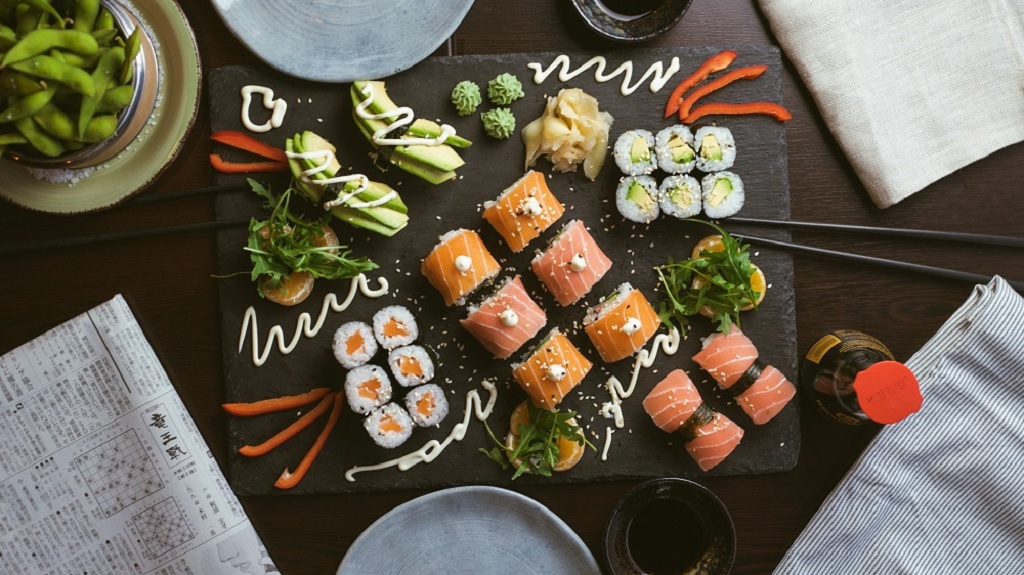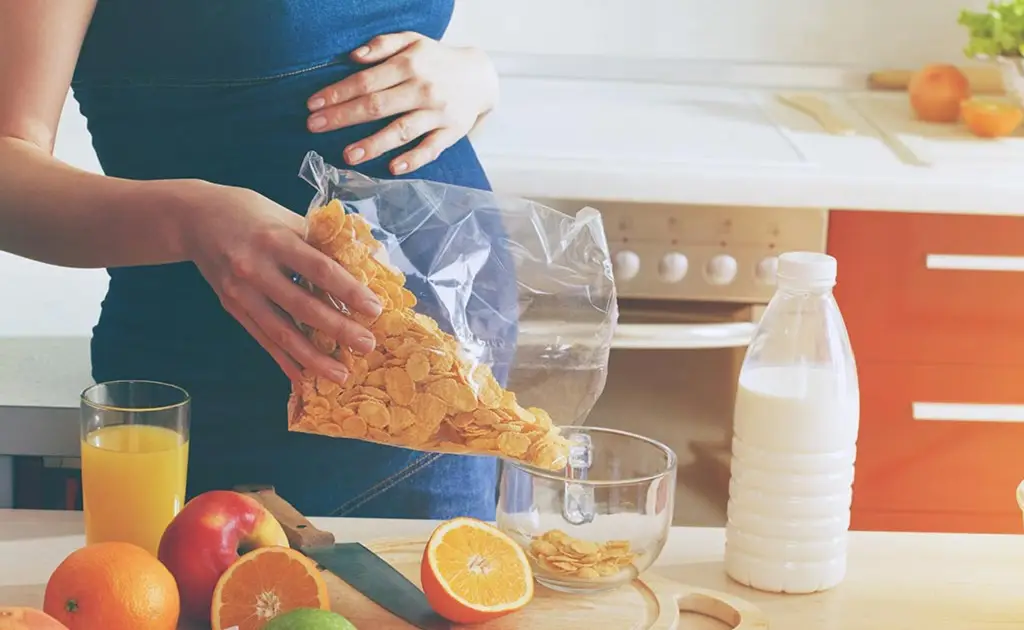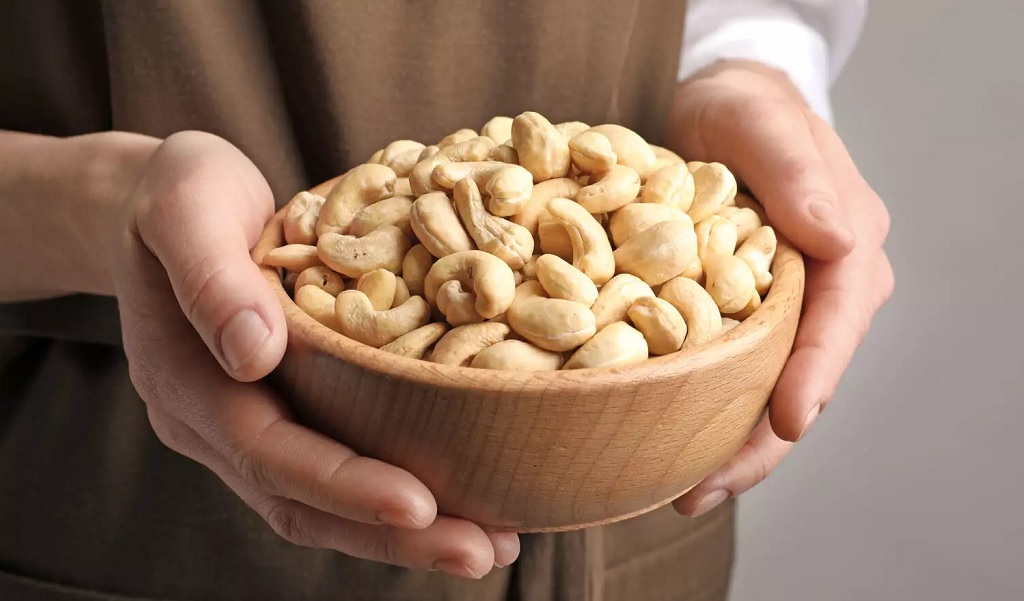How do you get omega-3 when pregnant? Chances are that your prenatal vitamin already has it. If not, it’s not hard to find one that does.
But you can also add foods with healthy fatty acids to your diet. Today’s article is all about omega-3 fatty acids foods for pregnancy.
Let’s start with an overview of the benefits of taking omega-3 when you’re pregnant.
The benefits of omega-3 fatty acids in pregnancy
Fatty acids help both you and your baby. For example, getting enough omega-3 makes sure that your baby’s eyes, brain, and nervous system develop properly. Omega-3 fatty acids also ensure that the baby has a good birth weight and isn’t born prematurely.
One study verified the benefits of omega-3 fatty acids taken during pregnancy. They found that mothers with high blood levels of DHA, an omega-3 fatty acid, had babies with a better attention span throughout the first 6 months of life (1).
Meanwhile, mothers with sufficient levels of omega-3 tended to suffer less from depression. And people who eat lots of fish and seafood or supplement with omega-3 often have better cardiovascular health with lower blood pressure and cholesterol (1).
What are omega-3 fatty acids anyway?
There are 3 types of omega-3 fatty acids: DHA, EPA, and ALA.
ALA, or alpha-linolenic acid, comes from plant sources like soybean, canola, and flaxseed.
DHA and EPA come from fish and seafood.
Your body can’t make ALA by itself – you have to eat, drink, or take supplements to get it. However, once your body has ALA, it can convert a small amount to EPA and DHA. But the best way to get those latter two is to supplement or eat the right foods.
Which omega-3 is best for pregnancy? They are all important in part of a balanced diet.
If you are vegetarian or vegan and choose not to eat fish and seafood, you’ll have to boost your diet with plenty of alpha-linolenic acid from plant sources. I’ll discuss that later on in the article.
What foods have omega-3 for pregnancy?
Obviously, fish, shrimp, oysters, and so on have lots of omega-3. But some seafood sources are problematic because they have high levels of mercury and may be contaminated with PCBs (polychlorinated biphenyls). These poisons are linked to birth defects (2).
On the bright side, some fish and seafood is safe enough to eat in moderation. The FDA recommends 2 meals a week with shellfish and fish like salmon and farmed oysters.
You can also get omega-3 from tofu, enriched soy milk, canola oil, green leafy vegetables like kale, and certain nuts and seeds. Keep reading to learn about all sorts of tasty foods with plenty of omega-3 for pregnancy.
Are there side effects of omega-3 in pregnancy?
There are no side effects to eating foods with omega-3 or taking supplements as long as you consume them in moderation. The biggest risk is eating too much seafood contaminated with PCBs or mercury. The same goes for omega-3 supplements. Make sure they are from a reputable manufacturer that verifies the purity of their products. If they carry a seal showing that they are NSF-certified or US Pharmacopeia-certified, then they’ve been independently tested for safety.
If you do end up taking omega-3 supplements, avoid cod liver oil unless your doctor says to try it. That’s because it has a lot of vitamin A. If you’re taking a prenatal vitamin, you may end up with too much vitamin A and that’s harmful to the baby.
At any rate, sometimes it’s not very pleasant to take fish oil pills because they cause fishy-tasting burps. It’s best to get the omega-3 you need from food.
How much omega-3 do you need when you’re pregnant?
The jury’s still out on this question. The current recommendation by the American College of Obstetricians and Gynecologists is 200 mg of DHA per day. (That’s because DHA has been studied in pregnancy and found to have important benefits for the baby) (2).
You’ll find that many prenatal vitamins provide at least this amount. But there’s no problem if you choose to eat the omega-3 instead of supplementing with pills.
When to start taking omega-3 in pregnancy?
Don’t delay; start getting enough omega-3 during pregnancy’s first trimester. Your baby’s brain starts to develop around the 5-week mark and it needs all those good fatty acids right away.
Even so, at the end of pregnancy, your baby’s brain is still developing. In fact, it’s at its peak and needs plenty of DHA. The omega-3 fatty acids will help you prevent preterm labor, too.
What are the best foods with omega-3 fatty acids?
Let’s start with fish.
Wild-caught salmon is packed with omega-3 fatty acids and tends to be low in mercury (unlike albacore tuna). Other cold-water fish like herring and sardines are also good sources (3).
If you’re not sure which fish is safe to eat during pregnancy, the Environmental Defense Fund has a Seafood Selector that can help you decide.
Also, remember that sushi with raw fish is off the menu during pregnancy. The risk of foodborne illness is too great with raw seafood. Stick to steamed, grilled, roasted, or poached fish to make sure you’ve killed off the bad bacteria. Lemon and lime or balsamic vinegar can take the edge off the oiliness and dill and cilantro help disguise the fishy flavor.
Chicken of the Sea Premium Skinless & Boneless Pink Salmon

The nice part about this salmon is that it’s ready to eat. You can put it in a salad, sandwich, or on crackers and it makes for a delicious meal with lots of protein and omega-3.
It’s packed in vegetable broth which makes it taste even nicer. It’s also low-calorie, with only 70 calories per serving.
No worries, there are no bones to deal with. Plus, you can get it in different flavors like Cracked Pepper, Lemon Chive, and Lemon Pepper.
By the way, salmon is without a doubt one of the best fish for omega-3. For every 6 ounces, you’ll get over 1000 mg of fatty acids.
King Oscar Wild Caught Brisling Sardines

Sardines are another excellent source of omega-3. For every 2 ounces, they have over 500 mg of fatty acids.
This brand packs Norwegian wild-caught sardines in pure spring water with no additives whatsoever. You may already be familiar with them if you’ve done the keto diet. Obviously, they are a protein-packed superfood.
Moreover, they are packaged in BPA-NI tins that won’t leach toxins into your food.
On the downside, these delicious sardines are whole fish which means they have bones. However, the bones are small and soft and you may find yourself just eating the fish without worrying about them.
If you prefer, the manufacturer also offers different flavors like Dijon mustard, zesty tomato, jalapeno peppers, Mediterranean-style, and extra virgin olive oil.
Bar Harbor Wild Herring Fillets

I hate to admit it, but I just can’t get into herring. Even these wood-smoked fillets with salt and cracked pepper haven’t won me over. So, don’t take my word for it. Take a look at the happy reviews from those who love this fish instead.
Herring are high in omega-3 and protein as well as calcium. A quarter cup has 11 g of protein with no trans fat or carbs. It provides 4% of the daily value of iron and calcium, too.
How can I get omega-3 without fish during pregnancy?
What about omega-3 foods for pregnancy if you’re a vegetarian? (Or maybe you just don’t like seafood).
PETA has a helpful selection of omega-3 recipes for vegans (4).
As I mentioned, plant sources are rich in alpha-linolenic acid or ALA which converts in the body to another omega-3 called EPA. You can also get DHA from algae oil, a marine plant source.
For instance, they suggest tofu spinach lasagna as both of the main ingredients have omega-3 fatty acids.
Then, there’s pesto made with basil and pumpkin seeds, another top source of omega 3.
When you eat oatmeal in the morning, you’re eating omega-3. If you combine it with walnuts and soy milk, you’ve added even more.
Top it all off with a kale protein smoothie with flaxseed oil and you’ve maximized your (vegan) omega-3 for the day.
Now, here are some more plant-based foods with omega-3.
Nature’s Eats Walnuts

Walnuts and butternuts are top sources of omega-3 fatty acids. Cashews also have some. But about 10% of oil extracted from walnuts is omega-3.
I prefer this brand of walnuts for multiple reasons. First, every time I’ve had them, they tasted very fresh. Next, they are neatly shelled without awkward little scraps left in the bag. And third, they are produced under rigorous standards for quality monitored by the FDA, the USDA, and the California Walnut Board.
It also helps that they come in a resealable bag so I don’t have to hunt down a clip.
FYI: a one-ounce serving of walnuts provides 2.5 g of alpha-linolenic acid. It also provides 50% of the daily value of manganese, 20% of copper 10% of phosphorous and magnesium, 4% of iron and potassium, and 2% of calcium. (But watch out for the calories – 1 ounce or a quarter-cup of walnuts is 190 calories!)
If you’re not into eating plain nuts, try enjoying walnuts with dried cranberries in your oatmeal or yogurt. It’s also nice to sprinkle walnuts on salads. You can also grind them up into a powder to mix with breadcrumbs for battering chicken or fish.
Quaker Old Fashioned Rolled Oats

If you want the maximum amount of omega-3 from oatmeal, go with whole oats, not instant oatmeal. Combine the oats with walnuts and enriched soy milk and you’ll get a good amount, plus fiber as well.
If oats are boring, spice them up with cinnamon and raisins. You can also go the extra mile with pumpkin spice (ginger, cinnamon, nutmeg, and clove). Yum!
Happy Belly Canola Oil

I used to cook exclusively with olive oil, but I’ve branched out recently. Now I use sesame when I want a richer flavor and canola when I want to fry things without smoking.
Did you know that canola oil was originally grown as biodiesel fuel? It has a low amount of saturated fats so it flows well in cold temperatures. Moreover, it has a high smoke point. You have to hit 435°F before it starts smoking.
Canola oil has a very light flavor, plus it’s rich in omega-3 fatty acids. It’s a great source of ALA that the body turns into DHA that the baby needs.
Unhydrogenated canola oil is about 10% alpha-linolenic acid. But flaxseed oil is even higher at 55%. Either way you go, they work well for frying, cooking, and even as salad oil.
It’s not hard to get plenty of omega-3 with a balanced diet
More plant sources of omega-3 include leafy greens like kale, Brussels sprouts, and spinach. You can use canola oil to roast Brussel sprouts with just salt and pepper and they turn out tasty.
Then, there’s tofu and edamame from soy. Either food (as long as it’s not marked as “low-fat”) has a lot of omega-3. Did you know that you can scramble tofu instead of eggs? You can also use it to make burritos or tacos. Since it’s nearly flavorless, it’s nice for thickening smoothies.
Lastly, you can even find omega-3 in unexpected places like chicken, beef, and seaweed. With regards to animal sources, they need to be pasture-raised or grass-fed.
Conclusion
I hope this article answered your questions about omega-3 fatty acid foods during pregnancy. It’s easy to get enough omega-3 each day through diet alone. There are many different sources from seafood to vegetables, seeds, and nuts that provide it.
If you have other questions about the best pregnancy diet or suggestions for omega-3 recipes, I’d love to hear from you. Feel free to leave me a comment below.
Sources:
1. https://www.webmd.com/baby/news/20040716/pregnant-omega-3-essential-for-babys-brain Pregnant? Omega-3 Essential for Baby’s Brain, Advanced Attention Span in Babies Whose Mothers Eat More Essential Fats, by Salynn Boyles, July 16, 2004
2. https://www.ncbi.nlm.nih.gov/pmc/articles/PMC3046737/ Coletta JM, Bell SJ, Roman AS. Omega-3 Fatty acids and pregnancy. Rev Obstet Gynecol. 2010 Fall;3(4):163-71. PMID: 21364848; PMCID: PMC3046737.
3. https://www.whattoexpect.com/pregnancy/your-health/omega-3-fish-oil-during-pregnancy Omega-3 Foods and Fish Oil During Pregnancy, by Maria Masters, Medically Reviewed by Rebecca Amaru, M.D. on November 1, 2021
4. https://www.peta.org/living/food/vegan-recipes-packed-with-omega-3s/ Vegan Guide to Omega-3s, Published May 8, 2015 by PETA. Last Updated December 10, 2020.





